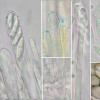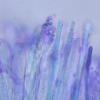
12-11-2025 09:25
 Viktorie Halasu
Viktorie Halasu
Hello, I need help with a pale terrestric Pseudom

11-11-2025 20:16
Bohan JiaHi, lastly I have found these tiny yellow decayin

09-11-2025 13:20
Hello.A tiny ascomycete, appearing as erupting gra

08-11-2025 00:29
 Francois Guay
Francois Guay
I found this species in Quebec, Canada, on herbace
Mollisia sur Pinus
Michel Hairaud,
08-11-2025 09:15
 Bonjour,
Bonjour, Pouvez vous m'aider à identifier ce Mollisia récolté sur Pinus sylvestris pourrissant sur sol calcaire :
- Apothécies de diamètre 3-4,5 mm. KOH négatif
- Asques 95-100 x 8-9µm, IKI Bleu , Crochets +
- Spores 12 - 14,5 µm, OCI 4
Paraphyses x3 -4 µm, avec bien sur une vacuole réfringente homogène mais souvent avec une guttule au sommet non réfringente .
Merci
Amitiés. Michel
Hans-Otto Baral,
08-11-2025 09:53

Re : Mollisia sur Pinus
Hi Michel
I would place this in Pyrenopeziza based on the araphysis contents. There is a folder "subalpine IKI3bb 13,3-14,5 x 3,2-4,4 +-egutt" which cannot be your species because of the low OCI.
The spores reminded me of M. ventosa, but this is impossible.
Did you measure the spore width?
Is it a collection from Deux-Sèvres fromthis November?
Zotto
Michel Hairaud,
08-11-2025 13:12

Re : Mollisia sur Pinus
Thanks Zotto.
Spores width = 3-3,8 µm
Your file subalpine IKI3 BB has a collection with many common characters with mine.
I would have excluded Pyrenopeziza because of the homogenous VBs in the paraphyses and the anchoring hyphae. See new pics.
I had also noticed the similarity with M. ventosa spores.
Yes Collection on this 4 November in the Chizé forest .
Michel
Spores width = 3-3,8 µm
Your file subalpine IKI3 BB has a collection with many common characters with mine.
I would have excluded Pyrenopeziza because of the homogenous VBs in the paraphyses and the anchoring hyphae. See new pics.
I had also noticed the similarity with M. ventosa spores.
Yes Collection on this 4 November in the Chizé forest .
Michel
Hans-Otto Baral,
08-11-2025 15:31

Re : Mollisia sur Pinus
Anchoring hyphae exist also in Pyrenopeziza. The refractive globose SCB iy very typical of Pyrenopeziza, while the VBs are very low-refractive. Pyrenopeziza has usually non-refractive vacuoles, but such occur sometimes. You can try DNA.



